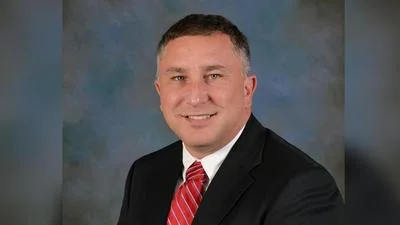Westmont Village Board: Left to right - Trustee Frank Brady, Trustee Marie Johanik-Guzzo, Village Clerk Jinny Szymski, Mayor Ron Gunter, Trustee Steve Nero, Trustee Linda Liddle, Trustee Bruce Barker, Trustee Amylee Hogan Simonovich | Westmont Village
Westmont Village Board: Left to right - Trustee Frank Brady, Trustee Marie Johanik-Guzzo, Village Clerk Jinny Szymski, Mayor Ron Gunter, Trustee Steve Nero, Trustee Linda Liddle, Trustee Bruce Barker, Trustee Amylee Hogan Simonovich | Westmont Village
Westmont Village Sub Committee - Residential Sprinkler met Aug. 28.
Here are the minutes provided by the committee:
Call to Order
Attendance/Introductions
Jill Ziegler, Vicki Senesac, Jim Long, Tim Ryan - Builder, Barry Waterman - Sprinkler Representative, Chief Weiss, Larry Kaufman, Steve May, Trustee Barry, Steve Vernon - Developer, Trustee Barker, Larry Forssberg
Pledge of Allegiance
Building Code amendment - Sprinkler requirement.
The current building code used by the Village is the 2003 code. Economic Development’s ISO rating was dropped from a 4 to a 10 due to using a code that is 11 years old. ISO will be at the Fire Department at the end of September. Municipal Services Director Steve May added that we will be adapting new building codes as of January 1st, 2015. The reason for this sub committee is to discuss whether we include the Residential Fire Sprinkler code.
The ISO rating and cost savings to residents was discussed. Chief Weiss stated that the Village can adopt the 2012 building codes, and leave out the Res. Sprinkler code, and E.D. can get a higher ISO score than currently have. The 2012 building code is an international building code that is used State/World wide. Larry Kaufman added that in the state of Illinois, there is a minimum code that has to be adopted, by State statute. This code is Life Safety 2000. Most municipalities north of I-80 have higher standards, and use a more restrictive code. It is better to be more restrictive that less.
It was discussed if this would just be for new residences, or would this affect remodels, additions etc. Cost of adding sprinklers to new homes was discussed. The cost could be $3.00 a square foot, which would put approx. cost of a 3,000 square foot home around $9,000. There is a possibility it could go to $4.00 a square foot, putting the approx. cost at $12,000. It was also mentioned if Sprinkling residential homes would save life or property. The 13D standard is strictly a life safety system. Studies were performed on how people die in residential fires, which decided how the system wasconfigured. Since this standard was put into effect, no life has been lost.
Continued discussion on survive ability, and doesn’t smoke kill more than fire. A smoke detector activates when smoke is detected, however, if this is in a 2 story home, and the detector goes off on the second floor, there could be a fire at the bottom of the stairs preventing people from exiting. With a sprinkler, the person would be able to get out. The question of how many deaths in the Village from fires was asked. Chief Weiss answered, in the 23 years he has been with the Village there have only been 5 deaths due to fire. Four in single family homes, 1 in a multi family bldg.
Staff suggestions - possible reduce fees, let residents/builder apply for life safety grant to help with cost. Reducing fees, means lost revenue for the Village.
Discussion resumed regarding how to enforce the sprinkler code. Would this be only new construction? Would this be made retroactive for older homes? What about additions? If not used for additions, remodels, this may decrease the number of residents making these changes to their homes. The ordinance pertaining to demolitions was also discussed, and the possibility that 1 wall could be left, while the rest of the house was demolished and it would be considered a remodel.
The possibility of a homeowner turning off the sprinkler was discussed. With the NFPA Standard #13D it is not possible to turn off the sprinkler system without turning off the water supply to the residence.
Discussion regarding maintenance or inspections of the sprinkler system. Under the Standard, maintenance is not required, however, like any mechanical component it is a good idea to have it checked. Chief Weiss recommends the system be tested every 5 years. Nothing goes bad, the sprinkler heads are good for 50 years. With a sprinkler system, the residence will have a backflow protector, this device under state plumbing code has to be checked yearly. The cost of this test is roughly $100.
Discussion ensued if this is worth the cost. One committee member does not think so. It was mentioned that a sprinkler system is much like home insurance, there is a cost to it, however it is there if you ever need it. A life is always worth the cost. Nationally every year there are 3,800 fatalities from fires, and 1,500 injuries.
Discussion once again ensued regarding the ISO rating and how it affects insurance cost for a homeowner/resident. There is no way to get a answer on a dollar amount. There are multiple insurance companies, which is why it is difficult, if not impossible to get a specific dollar amount.
Discussion regarding the surrounding towns/villages and what code they use. Most surrounding Villages are using the building codes from 2006, which does not include the Sprinkler systems for residence’s code.
Possible cutting of Fire Department staff was discussed. This would not be possible, the staff that the Village has is needed for fighting fires in non-sprinklered buildings. The possibility of sending one truck to a fire at a sprinklered structure was discussed. Downers Grove is currently utilizing that idea.
Chief Weiss gave more detail on how an ISO rating works. An ISO rating is between 1 and 10, 1 being best, and 10 being the worst. Currently the Westmont Fire Department has a ISO rating of 2. A rating of 1 or 2 is best. When there is a rating of 1, 2, or 3 there is a cost savings for commercial, when a 4, 5, or 6 there is a cost savings seen in residential. When the rating is 7 - 10 that is a really bad rating. This is how insurance companies would use the ISO rating for fire insurance. However, it is not known what insurance companies use it, and which ones do not. Which is why it is difficult to set a dollar amount.
Chairman Barker asked that additional questions and comments be directed to staff. Vicki Senesac reviewed the packet of information that was given to the committee for review.
Motion to adjourn. Meeting was adjourned at 5:12 pm.
https://westmont.illinois.gov/AgendaCenter/ViewFile/Minutes/_08262014-466






 Alerts Sign-up
Alerts Sign-up